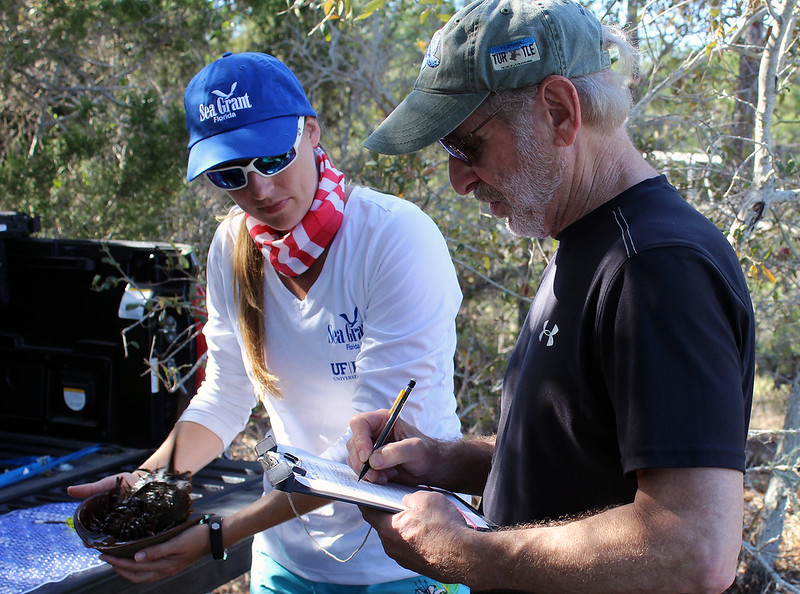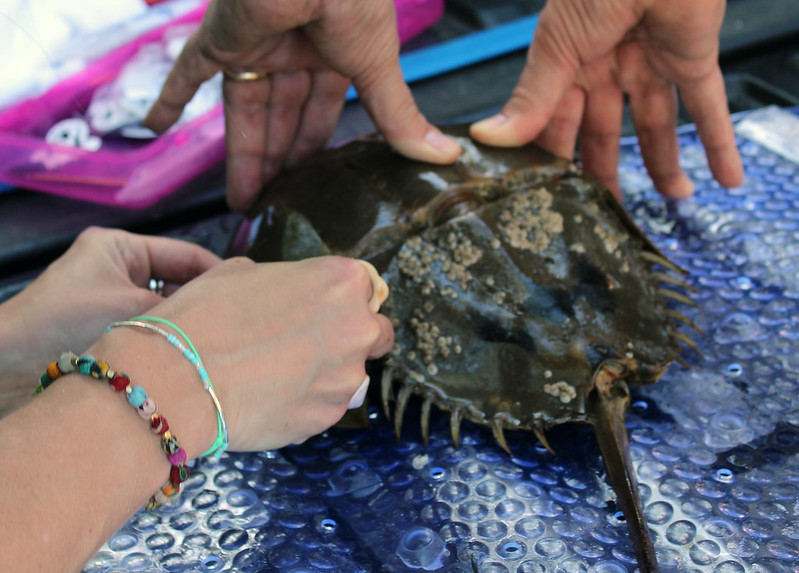
While Savanna Barry handles the crab, volunteer Gary Appelson, policy coordinator with the Sea Turtle Conservancy, records data. Florida Sea Grant photo
Editor’s note: This post was originally published in May 2017 on UF/IFAS News. Additional content and photos have been supplied by Florida Sea Grant.
As the weather warms, tourists won’t be the only ones heading to Florida’s beaches. Horseshoe crabs also come ashore this time of year, though they are more interested in finding a mate than getting a tan.
For Jane Brockmann, professor emeritus of biology at the University of Florida, the horseshoe crabs’ arrival is a chance to track and monitor these primeval-looking creatures.
With assistance from Florida Sea Grant, Brockmann and a few dozen volunteer citizen scientists are surveying horseshoe crabs along Florida’s Big Bend.
At the moment, it’s not clear how many horseshoe crabs are in Florida’s waters, but numbers have been declining for decades. Survey results will help scientists at the Florida Fish and Wildlife Conservation Commission estimate the crab’s current population numbers to determine if the species needs additional conservation measures.
Horseshoe crabs are an ancient but essential part of the coastal environment. “Horseshoe crab eggs are an important food for many shore birds, including the red knot, which may soon be listed as endangered,” said Savanna Barry, Florida Sea Grant agent with the UF/IFAS Nature Coast Biological Station.
“The eel and conch industries likewise rely on horseshoe crabs for bait.”
And if you’ve ever gotten medical treatment, you have horseshoe crabs to thank, Barry said.
“Their blood has a special property that makes it coagulate around bacteria, so it’s used to test medical devices and vaccines for contamination.”
As of now, citizen scientists are actively sampling for horseshoe crabs in Levy, Dixie and Taylor counties. But the project organizers hope it will eventually cover the entire state.
“Using citizen scientists lets us collect data over a larger area than we could cover with a typical research team,” said Barry, who trains volunteer scientists how to collect sound data before they go into the field.
Tiffany Black, a researcher with FWC who represents Florida on the Horseshoe Crab Technical Committee of the Atlantic States Marine Fisheries Commission, said the project helps fill a data gap for the species.
“To date, we’ve only been able to do a presence-absence study based on what people have reported online. But with citizen scientists, we can gather standardized data,” Black said. “Partnering with UF gives us reach throughout the state. We have 1,200 miles of shoreline, so we need to harness the power of researchers, UF/IFAS Extension agents and the public.”
Citizen science projects also let residents get involved with research happening in their communities.
“I grew up in Virginia and saw these crabs all my life. I was so excited to be part of the new research going on in the Gulf,” said Katie Granger, who has been volunteering with the horseshoe crab survey since its start. “The best part of helping with the surveys is being trained to care for these creatures and that I can go in the water, examine and tag them.”
Debbie Goad also grew up around horseshoe crabs and jumped at the chance to learn more about them. “I’ve enjoyed volunteering because I’m treated as an equal, even though my knowledge is limited, and I don’t have a science background,” she said.
If you see a tagged horseshoe crab, please note the number on the tag and use the hotline (1-888-LIMULUS) or www.fws.gov/crabtag to report the number, sighting location and condition of the crab.




